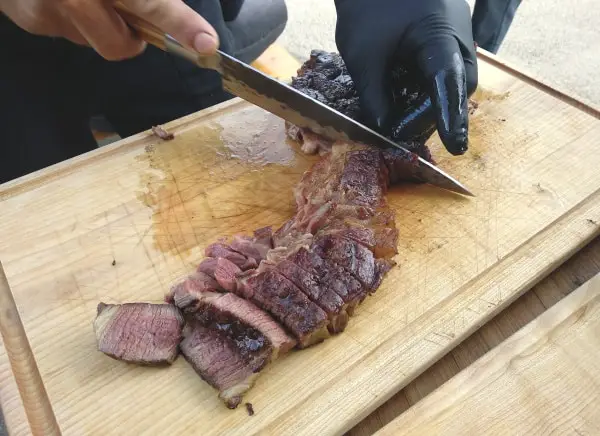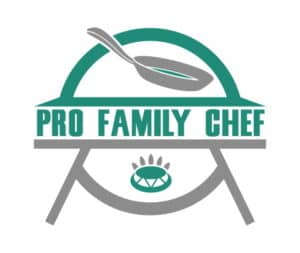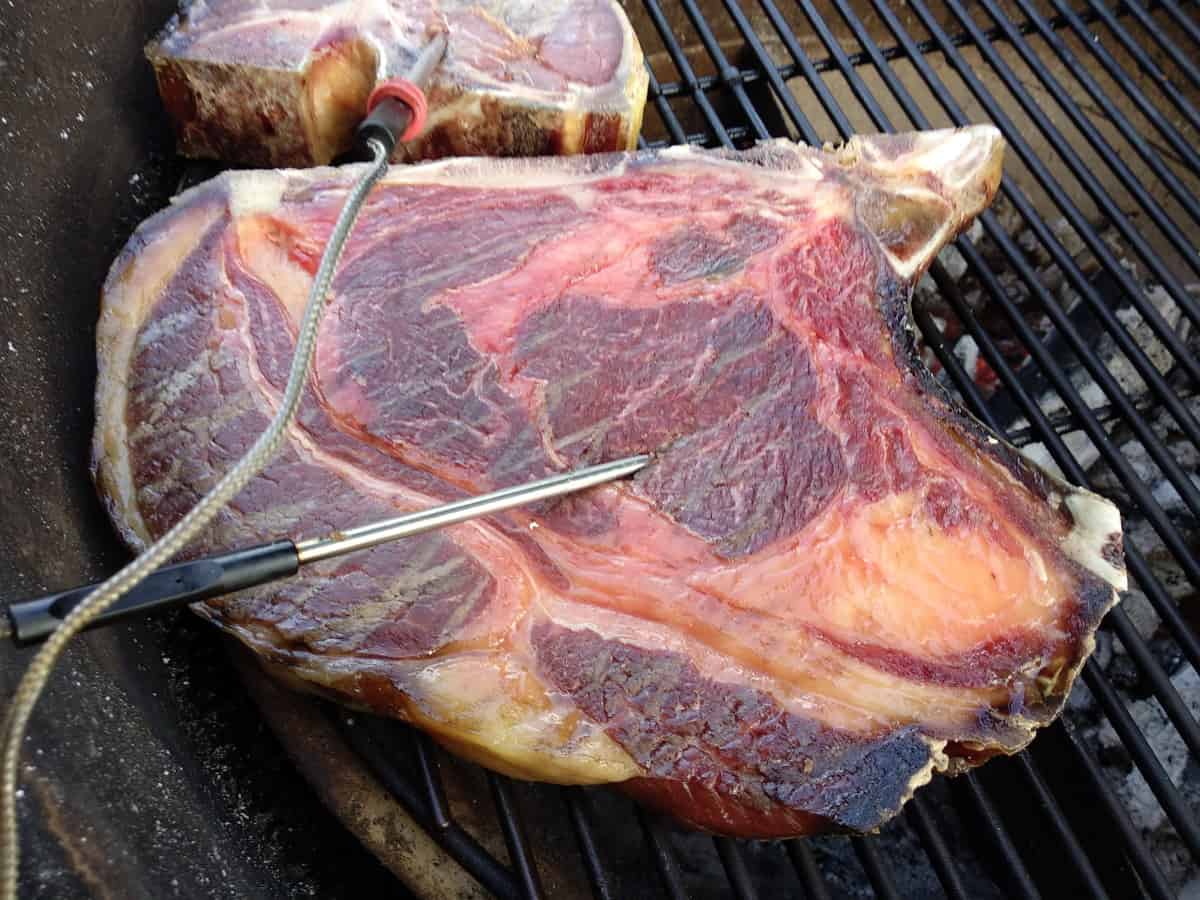Fresh meat, including chops, roast, and steaks, may be consumed medium-rare. The meat should be cooked until it reaches an internal temperature of 145°F. Then it should be allowed to sit for up to three minutes before consuming or cutting.
Other types of meat, such as ground meat, including pork, beef, and chicken, should preferably be cooked to an internal temperature of well done (160 °F). It is generally accepted that chicken should be cooked all the way through.
Seafood should be cooked all the way through until the color is opaque and the texture is firm. This includes fish, lobster, shrimp, and scallops.
Game meat, except for wild boar and bear, maybe eaten medium rare, you can check more game meat in this artikel here. This has more to do with preference than the minimum recommended cooking temperatures. There are, however, risks associated with consuming undercooked game meat.
If you are wondering about whether you can eat fish, burgers, or sausages, medium rare, you can check this by clicking on each meat type or particular meat in the table below.
List of all the meat you can or can not eat medium rare.
| What meat can you eat medium rare | ||
|---|---|---|
| Meat | Can you eat or serve it medium rare | Temperature |
| Beef | Yes | Best cooked 145°F (63°C) internal temp |
| Angus beef | Yes | Best cooked 145°F (63°C) internal temp |
| Pork | Yes | Best cooked 145°F (63°C) internal temp |
| Chicken | No | Recomended 165°F (74°C) internal temp |
| Bacon | No | Should be cooked thoroughly |
| Seafood | No | Best cooked all the way through |
| Lamb | Yes | Best cooked 145°F (63°C) internal temp |
| Veal | Yes | Best cooked 145°F (63°C) internal temp |
| Turkey | No | Recomended 165°F (74°C) internal temp |
| Goat | Yes | Best cooked 145°F (63°C) internal temp |
| Horse | No | Recomended 180°F (82°C) internal temp |
| Rabbit | No | Recomended 160°F (71°C) internal temp |
| Duck | Yes | Best cooked 130°F to 135°F (54°C - 57°C) |
| Liver | Yes | USDA recommends 160°F (71°C) internal temp - this is well done temp. |
| FISH | ||
| Salmon | Yes | Best cooked 110°F to 140°F (43°C - 60°C) |
| Tuna | Yes | Best cooked 130°F to 140°F (54°C - 60°C) |
| Sea bass | No | Best cooked medium to medium-well |
| Tilapia | No | Best cooked medium or well done |
| Halibut | Yes | Best cooked 125 °F to 135 °F (51°C - 57°C) |
| Swordfish | Yes | Best cooked 130 °F (54°C) |
| Trout | No | Best cooked medium to medium-well |
| Mahi | Yes | Best cooked 137 °F (58°C) |
| Cod | No | Best cooked 140 °F (60°C) internal temp |
| BURGERS - GROUND MEAT | ||
| Beef burger | No | Best cooked medium to medium-well |
| Pork burger | No | Recomended 160°F (71°C) internal temp |
| Turkey burger | No | Best cooked well done |
| Lamb burger | No | Recomended 160°F (71°C) internal temp |
| Venison burger | No | Recomended 160°F (71°C) internal temp |
| Bison burger | No | Recomended 160°F (71°C) internal temp |
| Ground goat | No | Recomended 160°F (71°C) internal temp |
| SAUSAGES | ||
| Beef sausages | No | Recomended 160°F (71°C) internal temp |
| Poultry sausages | No | Recomended 165°F (74°C) internal temp |
| Italian sausage | No | Recomended 165°F (74°C) internal temp |
| Brats (Bratwursts sausages) | No | Recomended 165°F (74°C) internal temp |
| GAME MEAT | ||
| Venison meat | Yes | Best cooked 145°F (63°C) internal temp |
| Wild boar | No | Best cooked all the way through |
| Bear | No | Best cooked all the way through |
| Bison meat | Yes | Best cooked 145°F (63°C) internal temp |
| Elk meat | Yes | Best cooked 135°F to 140°F (57°C - 60°C) internal temp |
| Aligator meat | Yes | Best cooked 140°F (60°C) internal temp |
| Camel meat | Yes | Best cooked 135°F (57°C) internal temp |
| Dove meat | Yes | Best cooked 135°F (57°C) internal temp |
| Wild duck meat | Yes | Best cooked 130°F to 135°F (54°C - 57°C) |
| Squab meat | Yes | Best cooked 130°F to 135°F (54°C - 57°C) |
| Goose meat | Yes | Best cooked 135°F to 145°F (57°C - 63°C) |
| Emu meat | Yes | Best cooked 145°F to 160°F (63°C - 71°C) |
| Moose meat | Yes | Best cooked 140 °F (60°C) internal temp |
| Pheasant meat | Yes | Best cooked 145°F (63°C) internal temp |
| Ostrich meat | Yes | Best cooked 130°F to 135°F (54°C - 57°C) |
Can you eat medium rare beef
Yes, you can eat medium rare beef.

It is common knowledge that pathogens such as E. coli are found on the surface of red meat. However, these bacteria cannot penetrate the dense flesh of red meat.
So if you cook a steak to an internal temperature of 145 °F, the inside is safe to eat. Silverside can also be cooked to an internal temperature of 145 °F.
Ground beef sometimes referred to as minced beef, should be consumed well done. According to the USDA and FDA, it should not be consumed medium rare. As mentioned earlier, pathogens contaminate the surface of the meat.
Once the meat is ground, the pathogens are in all parts of the meat. Therefore, medium-rare ground beef is unsafe to eat.
It is possible to eat ribs medium rare, but the meat will taste a bit tougher. If you cook it all the way through, the meat will fall off the bone.
Can you eat Angus beef medium rare
Yes, you can eat medium rare Angus beef.
The USDA recommends consuming Angus beef at an internal temperature of 145 °F. In 2011, the USDA revised its minimum cooking temperatures.
This is the safest minimum temperature to consume Angus beef.
Angus beef is different from regular beef in that it has more marbling. Marbling is the fat that is found in the flesh of the meat. It’s this marbling that gives the steak its delicious flavor.
Can you eat medium-rare beef the next day
If you follow the proper procedure for storing meat, you can eat medium rare beef the next day.
However, there are a few points that need to be emphasized on this particular subject.
The way you reheat the steak will determine whether the meat will continue to cook. For example, if you reheat the steak in the microwave, there is a risk that the steak will cook even more.
In the microwave, the internal temperature is cooked first before the external temperature is increased.
Allow the beef to cool for about 30 minutes before searing it in a pan to reheat.
Can you eat medium rare pork
Yes, you can consume medium rare pork.
The USDA has lowered the minimum temperature for pork to 145 °F.
Pork harbors a parasitic roundworm known as Trichinella spiralis. Infection with the worm can be fatal. Infection with it is known as trichinosis.
This worm is killed once the outside temperature of the pork reaches 140-145 °F. The meat must be held at 140-145 °F for several minutes after reaching the desired internal temperature.
The lowest and safest temperature for pork consumption is 140 °F or medium rare. The worm can also be eliminated by freezing the meat.
Can you eat ground pork medium rare
No. It is not safe to consume undercooked ground meat.
You cannot eat medium rare ground pork. As mentioned earlier, pigs harbor a virus known as Trichinella spiralis. When the meat is ground, it means that the surface meat is mixed with the inner meat.
The USDA recommends that ground meat be heated to an internal temperature of 160 °F. This is the minimum safe temperature for eating ground pork.
Can you eat medium rare bacon
No, it is not safe to eat raw bacon.
This is because eating medium rare or raw bacon carries an increased risk of food poisoning.
Bacon should be cooked thoroughly. Eating inadequately cooked bacon can expose you to parasites and bacteria. This can cause gastrointestinal symptoms and make you very sick. If you only check the color for doneness, you should know that some bacon may retain its natural pink color even after cooking.
Bacon is unsafe to eat if it has turned gray or brown with a hint of blue or green. This color change occurs when the bacon is exposed to the air.
Can you eat medium rare lamb
It is safe to eat lamb medium rare. Medium rare lamb internal temp is 145°F (63°C).
As with beef, most bacteria are on the surface of the meat. The cooking method ensures that all bacteria are killed before the lamb is consumed. This is especially true for lamb chops, which are often served medium rare in restaurants.
Lamb shanks require a different cooking method than lamb chops. Lamb shanks are often cooked at low heat for an extended period of time.
Therefore, the temperature does not really matter in this equation. It is possible to eat lamb shanks medium rare.
Lamb shanks are a juicy and flavorful cut of meat. Opinions vary widely on the internal temperature of lamb shanks. Because this piece is so tender, it tastes great regardless of how well the meat is cooked.
The lamb shoulder should preferably be cooked to an internal temperature of 160 °F – 170 °F. The color of the meat will be gray-brown. Always use a thermometer to check the cooked state of the meat.
Always ensure the safe preparation of meat before consumption.
Can you eat Veal medium rare
Yes, you can consume medium rare veal.
It is one of the most expensive cuts of meat. It is tender and flavorful. Veal is considered a delicacy and is very popular on the menu in most European countries.
Veal is the meat of calves of a dairy breed, a crossbreed, or a breed of cattle.
Veal roasts, chops, and steaks should be cooked to an internal temperature of 145°F (63°C). This is a minimum safe temperature for veal recognized by chefs and Food&Safety.gov.
Can you eat medium rare chicken
No, you cannot eat medium rare chicken.
Most chicken has salmonella or campylobacter on the surface of the meat.
Chicken meat has a lower density than beef, sheep, cow, or pork. This means that the bacteria can travel through the meat of the chicken. For this reason, the chicken should be cooked to an internal temperature of 165 °F throughout.
The USDA sets out clear guidelines for the cooking method and temperature of chicken.
Can you eat turkey medium rare
The answer is no.
All poultry must be cooked to a minimum internal temperature of 165 °F. This ensures that all bacteria, viruses, and pathogens are killed during this process. Both the USDA and chefs agree on this issue.
Eating inadequately cooked turkey poses serious risks. Food poisoning from salmonella is often caused by eating undercooked poultry meat.
Using a meat thermometer should help you determine the proper internal temperature of the meat before eating it.
Can you eat medium rare goat
Yes, you can consume goat meat medium rare.
Goat meat has a delicious, slightly gamey flavor. It is a healthier alternative to other red meats. The meat is nutritious and very lean. It contains iron, less fat and saturated fat, and the same amount of protein as other meats like beef or pork.
The meat is versatile and can be prepared in various cultural dishes such as curries, Jamaican stews, and Mexican dishes.
Similar to beef, goat meat can also be eaten medium rare as per the USDA. However, ground goat meat should be consumed at an internal temperature of 160 °F.
Can you eat horse meat medium rare
No, you cannot and should not eat horse meat medium rare.
Horse meat looks like beef, but it contains yellow fat and is coarser and darker than regular beef. While the thought of eating horse meat is off-putting to some, it is considered a delicacy in other regions of the world. This has mostly to do with cultural norms.
Horse meat requires higher cooking temperatures, and it is recommended that the meat be cooked to an internal temperature of 180 °F.
However, it must be mentioned that there have been countless outbreaks due to the consumption of undercooked horse meat.
Can you eat medium rare rabbit meat
It is not recommended or advised to eat rabbit meat medium rare.
Rabbit is not as popular as chicken, beef, or pork. Rabbit is considered game meat. It is very lean, tastes delicious, and is rich in protein, vitamin B12, omega-3 fatty acids, and minerals such as calcium and potassium.
Rabbit meat should be prepared similarly to chicken. Improperly cooked rabbit meat can expose you to tularemia bacteria which can be found in this type of meat. The USDA recommends preparing rabbit meat well done or with an internal temperature of at least 160 °F. This meat should be cooked quickly over high heat.
Can you eat medium rare duck
Yes, you can consume duck medium rare. This is popular in most upscale restaurants and a trend among chefs to serve duck slightly undercooked.
Duck is a very lean meat with most of the fat sitting under the skin of the bird. Slow roasting the meat melts the fat and adds flavor to the meat.
Even though this is a popular trend, it goes against the guidelines that say all poultry should be cooked to an internal temperature of 165 °F.
Can you eat liver medium rare
The answer to this question is a little tricky. You can eat liver medium rare, but the USDA recommends cooking liver well done or with an internal temperature of at least 160 °F. The reason for this is that liver can contain bacteria and pathogens that can lead to food poisoning.
Cooking liver through will kill harmful microorganisms. Of course, these are just guidelines and not hard and fast rules. It is important to understand the risk associated with eating undercooked meat if you choose to eat it as such.
Eating undercooked pork liver puts you at risk of contracting the hepatitis E virus, while eating undercooked chicken liver puts you at risk of contracting salmonella or campylobacter, or other bacteria that can cause food poisoning. The CDC advises cooking chicken livers to an internal temperature of 165 °F. It is not recommended to undercook beef liver either.
Ideally, livers should be cooked until no blood is visible. Color is not an indicator for some types of livers, as studies suggest that they may retain the pink hue even after cooking to a safe internal temperature.
Also, bear in mind that restaurant cooking trends may differ from what is advised. You should always use your own preference.
A side note
Red meats such as lamb and beef can be eaten at a temperature of 145 °F or medium rare.
Poultry, ground meat, pork, and seafood should be cooked all the way through.
Most types of game meats can be eaten medium rare. However, the USDA advises that all types of game meat be consumed at an internal temperature of 160 °F or well done.
When preparing any type of meat, always check the USDA or CDC websites for information on the safe cooking temperature of the meat you plan to prepare. Remember that most meats contain pathogens and bacteria that can only be killed by cooking the meat at a specific temperature.
Even though the USDA and CDC specify minimum temperatures for all meats, that does not mean the meat can not be eaten at lower temperatures. It can be consumed at a lower temperature, but you should be aware of the risks associated with such a decision.
Conclusion
Some people prefer their meat cooked all the way through, while others prefer lower temperatures. For some, temperature is critical to the quality of the end result.
There are minimum cooking temperatures to keep us healthy and prevent us from contracting food-borne illnesses. Therefore, it is best to follow these guidelines and stay on the safe side.

